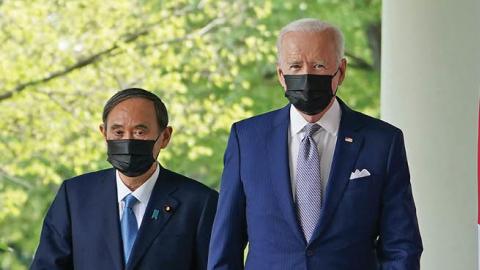On April 16, 2021, Prime Minister Yoshihide Suga of Japan became the first foreign leader to meet with President Joseph Biden in person since the president took office in January.
This was a historic summit for both leaders. Not merely a symbolic gesture of the close relationship between the U.S. and Japan, it represented an opportunity for both countries to draw greater attention to their efforts to address mutual challenges like China and climate change. The following are the top five takeaways.
1. The U.S.-Japan relationship isn’t just an alliance, it’s a friendship. The U.S. and Japan share common values, a mutual defense, and importantly, a close friendship. According to a recent poll, 84 percent of Americans hold a favorable view of Japan, a marked change from thirty years ago, when only 48 percent of Americans liked Japan. The reason for the change is that fewer Americans see Japan as an economic rival.
Biden and Suga tried to showcase their own close relationship during a joint press conference by referring to each other by first name—“Yoshi” and “Joe,” and Prime Minister Suga even mentioned that the U.S. is Japan’s best friend. Certainly, the U.S. and Japan forged a strong bond ten years ago as American efforts provided support in the wake of the March 11th Great East Japan Earthquake.
2. Biden and Suga want to cooperate, and look to the future. Even though Biden and Suga are septuagenarians (individuals in their 70s), their sights are nonetheless set on the future – announcing two new initiatives focused on technology and climate change.
The first, technology-related initiative, called the Competitiveness and Resilience Partnership, will invest in developing communication and information-sharing alternatives. The Partnership includes a combined $4.5 billion investment in next-generation telecommunications.
The focus of the second initiative is the U.S.-Japan commitment to decarbonization. Both countries have committed to upholding the Paris Agreement on climate change. In addition, they’ve agreed to cooperate in assisting developing countries in the Indo-Pacific to increase deployment of renewable energy. With twenty years of slow economic growth, Japan hopes that investing in digitalization and green technologies will drive future economic growth.
3. The Biden-Suga summit was more about momentum than new efforts. Even though it’s only been a few months since President Biden assumed office, both administrations have been busy with high-level American and Japanese official meetings. The summit was just a continuation of those efforts.
Unfortunately, details related to some newer areas of cooperation were lacking. For example, since COVID-19 has shaken global supply chains, Biden and Suga agreed to cooperate on sensitive supply chains. Distribution of semiconductors, small microelectronic chips included in electronic devices, has, in particular, been disrupted over the last year. The only solution Congress and the Biden administration have advanced so far is handing out $50 billion in subsidies for chip manufacturing.
4. The U.S. and Japan still have conflicting interests on trade. The U.S. and Japan are worlds apart on trade issues these days. Suga has described Japan as the “flag-bearer” for free trade. Having recently signed two mega-trade agreements in Asia and a trade deal with the European Union, , it’s hard to argue with that assessment. And as chair of the notorious Trans-Pacific Partnership (now called CPTPP), Japan looks to include new members. The U.S., however, won’t be one of them.
Given the atmosphere in Washington around trade issues these days, the U.S. will apparently not be signing any new trade deals anytime soon, even though good arguments can be made for the U.S. to pursue such agreements with Taiwan, Vietnam, and others.
5. The safety of Taiwan is important for the U.S. and to Japan. For the first time in nearly 51 years, a joint leaders’ statement reaffirmed U.S.-Japan commitment to peace and stability in Taiwan. The safety of Taiwan is an increasingly important concern for the U.S. and Japan, as China increases its efforts to intimidate and absorb the island nation, which is a strong partner of the U.S. and Japan, especially in semiconductor manufacturing. The momentum created by the two countries’ concern for Taiwan should continue, with U.S.-Japan engagements with Taiwanese officials increasing.
In conclusion, this summit represented more than simply a one-off meeting. The current U.S.-Japan relationship has strong momentum, with Biden and Suga already planning on attending a Climate Leaders Summit. The U.S. can’t address these issues alone, and so having Japan as a partner will be invaluable.



















